SCRAPERITEPLASTSKRAPOR
Professionella plastskrapor för säker och effektiv rengöring och skrapning
Big Gripper - Orange
BGR400GPO
Lil’ Gripper Orange pack
SR25LGYVAR
Lil’ Gripper Mix pack
SR25LGYVAR
Wide Gripper – Orange
SRTW6GPO
Demonstrationer och Guide
Säkerhet Först
ScrapeRite plastskrapor är designade för att vara säkra för både ytor och användare. Till skillnad från metallskrapor repar eller skadar de inte ytorna.
Användningsområden
- Fönsterputs - ta bort klistermärken och färg
- Bilrekond - säker rengöring av lack och rutor
- Köksrengöring - spisar och bänkskivor
- Industriell användning - utrustning och maskiner
- Marin - båtunderhåll och rengöring
- Bygg - städning och färgborttagning
Användningstips
Product Demonstrations
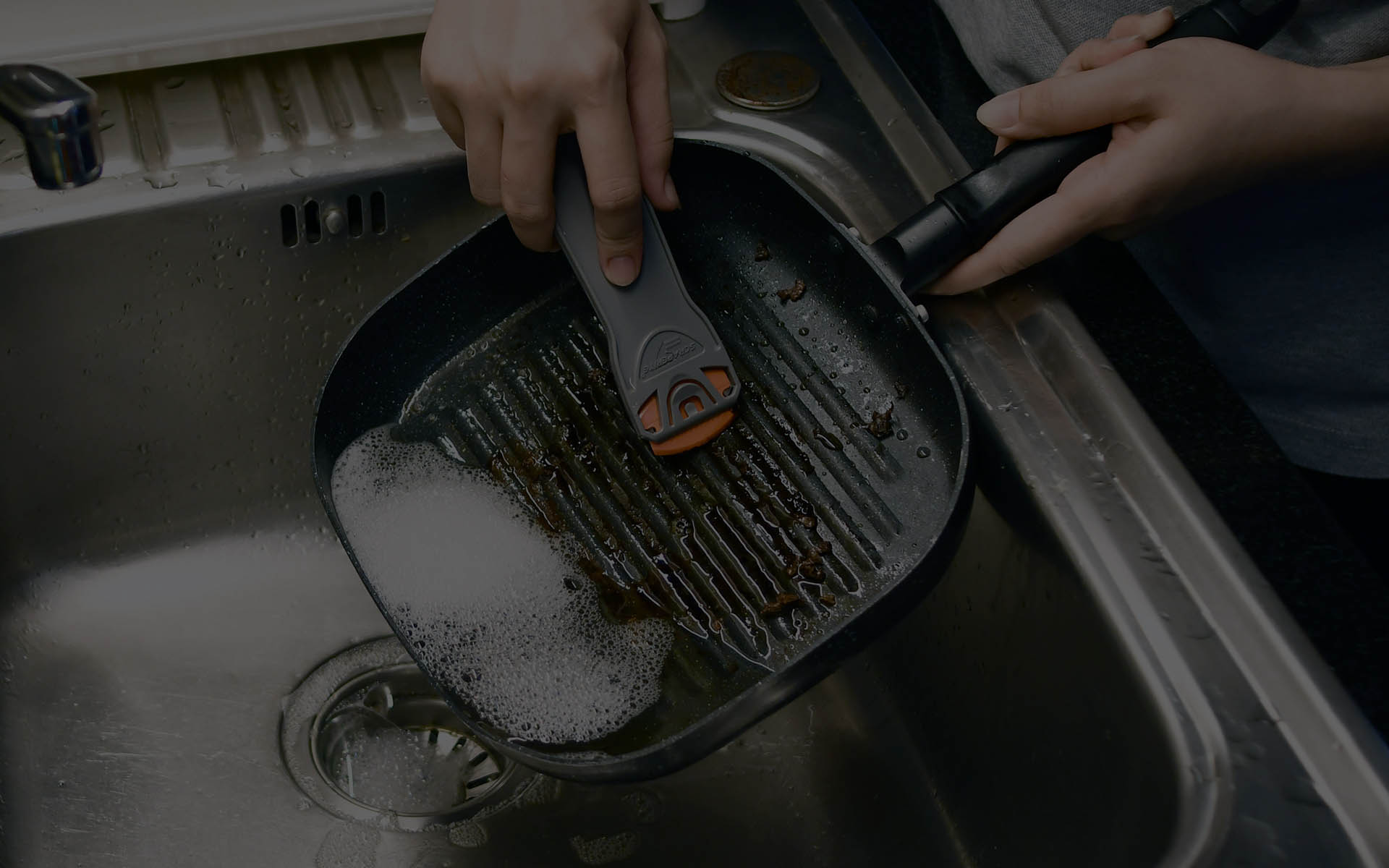
Vad De Säger Om Våra Produkter
Här är åsikterna från några youtubers som har testat våra produkter, visar hur man använder Scraperite plastblad och delar med sig av sina erfarenheter med sina följare.
Detta blad kan vanligtvis användas direkt på ytan av färgen eller plasten på din bil utan skador eller repor. Detta är den mest kemikalieresistenta sammansättningen, den motstår nästan allt.- RT MediaSolutions
Vad Scraperite plastblad är bra för är alla uppgifter där du behöver skrapa av något försiktigt från en yta som du inte vill repa upp med vanlig rakblad eller palettkniv.- Cool Tools
Introducerar det skonsammaste systemet för att skrapa eller ta bort självhäftande bokstäver, limrester, tätningsmedel etc. Använd Scraperite plastblad.- Pélitool
Jag började nyligen ta bort grafik från mitt fordon och tänkte dela med mig av denna metod som fungerade framgångsrikt för mig.- Clint Boland
Big Gripper - Orange
BGR400GPO
Lil’ Gripper Orange pack
SR25LGYVAR
Lil’ Gripper Mix pack
SR25LGYVAR
Wide Gripper – Orange
SRTW6GPO
Latest Posts
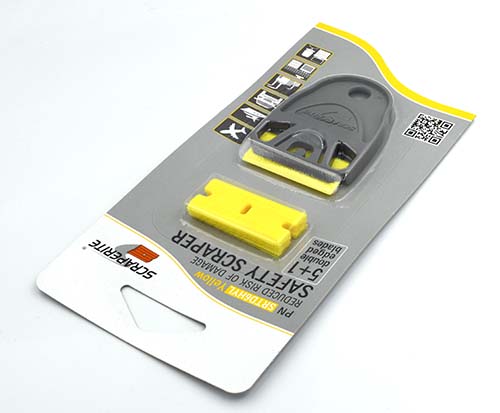
How to Remove Stickers, Decals and Adhesive Residue from Storefront Glass
Identifying the Type of Sticker on Commercial Glass Different adhesives require tailored approaches for effectively cleaning residue from commercial glass. Businesses often use various types of stickers, window clings, and decals for promotional purposes. Here are some common types: Vinyl Clings: These are favored for their reusability, adhering to glass through static or water-based methods, allowing for easy removal without leaving residue. Glassine Paper Stickers: Designed to remain firmly attached, these stickers can be challenging to remove without specialized solvents. Polypropylene Labels: Renowned for their durability and water resistance, these stickers are ideal for long-term applications but may leave behind stubborn adhesive residue. Clear Window Decals: Printed on transparent materials, these decals provide an appealing visual effect. The adhesives used can vary, impacting the ease of removal. Perforated Window Decals: Featuring small holes for one-way visibility, these decals utilize a stronger adhesive, making removal somewhat more difficult. Recognizing the type of sticker or cling you are dealing with will help ensure a successful removal process without damaging the glass. Start with a Basic Detergent Solution and a Plastic or Silicone Scrubber Removing adhesive residue from glass can be challenging, especially if it has dried and hardened. Before resorting to strong chemicals, begin with a simple method: Mix a grease-cutting detergent, such as blue Dawn, with hot water. Use a plastic or silicone scrubber to apply this solution to the residue, scrubbing in small circular motions until the adhesive starts to break down. Avoid metallic scrubbers, as they can scratch the glass surface permanently. Use a Scraper for Large Pieces of Cling or Sticker For larger remnants of the cling or sticker Scraperite is the perfect tool. Scraperite plastic blades are engineered for specific applications and chemical resistance. To learn more about the different Scraperite blade characteristics and which chemical solvents they work with visit our blade characteristics page. First, saturate the area with your cleaning solution, then employ the scraper using short, steady strokes to remove the material. Plastic Razor Blades a Safer Alternative to Metal a safety scraper tool by scraperite with pro magenta plastic razor blades While a metal razor blade may seem like a viable option, it poses a risk of damaging the glass. Instead, consider using Scraperite Pro Magenta Blades, which are designed to be sturdy and rigid enough to effectively remove stickers and adhesives from glass without scratching. For Stubborn Adhesives, Use Specialized Solvents with Caution When dealing with glassine paper stickers or polypropylene label residues on commercial glass, caution is essential. Utilize dedicated solvents that are specifically formulated for this task, adhering to safety procedures. Wear protective gloves and eyewear, and ensure proper ventilation. Rushing through the process or selecting the wrong solvent could lead to damage, so take your time and work carefully. Conclude with a Window Cleaner and Lint-Free Cloth After successfully removing the adhesive residue, finish the job with a window cleaner and a polish. This will ensure your windows appear sparkling clean. Use your preferred window cleaning solution or a natural mix of white vinegar and water. To dry the glass, select a lint-free cloth to prevent streaks or residue. Your customers will appreciate entering a space with pristine, shining windows that enhance your business's professional and welcoming appearance.
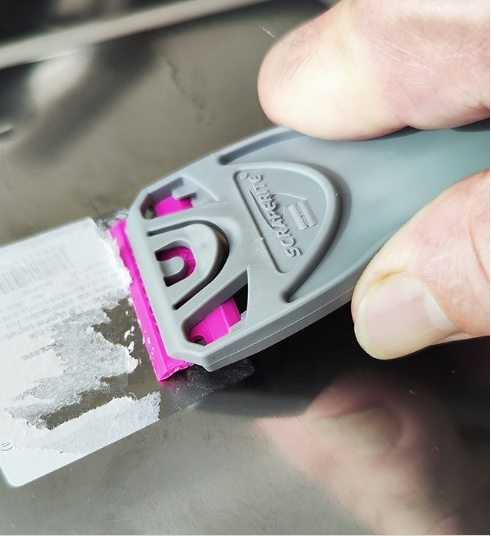
Effective Techniques for Removing Labels and Sticker Residue
Removing stubborn price tags or jar labels can often be a hassle. Below, we outline four effective methods for eliminating labels and sticker residue without damaging your items, along with tips specific to various surfaces (glass, metal, etc.). These techniques are suitable for both removing labels from our products at OnlineLabels.com and for tackling labels from store-bought items. Each method will require some scraping with a reliable safety scraper, which is where Scraperite comes in. Always test your chosen removal method on a small, inconspicuous area first to assess any potential reactions between the removal solution and your item. If you have clean jars ready for labeling, consider getting professional-quality labels custom printed by us! Recommended Methods for Label Removal Here are four recommended methods for safely removing labels without harming your object: Method 1: Nail Polish Remover and Rubbing Alcohol Apply a generous amount of nail polish remover to a cotton ball, cloth, or paper towel. Place the cloth on the label and allow it to soak in. Begin to peel the label off, using a Scraperite to eliminate any leftover residue, then wipe the area clean with a damp cloth. Method 2: Warm Water Fill a sink or container with warm-to-hot water and mix in a scoop of OxiClean® or dish detergent for added strength. Submerge the item and allow it to soak. Stronger adhesives may require longer soaking times—overnight may be necessary for tough labels. Once ready, peel one corner of the label, which should come off easily. Use a Scraperite to scrape away any remaining residue and wipe clean with a cloth or sponge. For labels on empty bottles, filling the bottle with warm water can be beneficial. Method 3: Hair Dryer Use a hair dryer set on warm, applying heat to the label in 1-minute intervals. The heat will loosen the adhesive. Continue moving the hair dryer across the label until it peels off completely. After removal, use a Scraperite to scrape off any residue and wipe the area clean with a cloth or sponge. Method 4: Vinegar Warm white vinegar in the microwave or on the stovetop, ensuring it doesn't boil. Submerge your item in the warm vinegar if it fits, or soak a cloth in vinegar and drape it over the label. Allow the vinegar to penetrate the label for 15-30 minutes. Remove the item and peel one corner of the label; the rest should come off easily. Use a Scraperite to remove any leftover adhesive and clean with a cloth or sponge. Method 5: Label Removal Sprays and Chemicals Use label removal sprays such as Goo Gone for stubborn residues. Spray a generous amount on the label, then place a cloth or paper towel over it. Let it sit for 15-30 minutes to soak in. Remove the cloth and begin peeling the label from the corners. Use a Scraperite to eliminate any remaining residue and wipe clean with a cloth or sponge. Surface-Specific Tips for Label RemovalGlass Glass is a common surface for labels. The most straightforward method for removing labels from glass is soaking the item in plain water; no dish soap is required. This technique works especially well for wine, beer, and water bottles, as well as food jars. Metal and Tin For textured or shiny metal surfaces, soaking the label with a wet rag will yield the best results. Secure the damp cloth over the label and let it sit until the adhesive weakens. Plastic Labels tend to adhere strongly to plastic, requiring more robust removal methods. Nail polish remover, rubbing alcohol, vinegar, or a hair dryer are effective choices, as they break down the adhesive for easier removal. Common plastic items include food jars, storage containers, household goods, and children's toys. Ceramic Paper labels are commonly used on ceramic items, which can tear easily, leaving behind sticky residues. Using vinegar is effective for removing both the entire label and any leftover adhesive on mugs, plates, and other ceramics. Porcelain Similar to ceramics, porcelain items often feature paper labels. These labels may peel off initially but can tear into small pieces. The vinegar method is effective for removing any remaining adhesive, ensuring a clean surface.
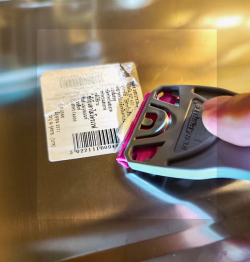
Mastering Sticker Removal
Removing stickers, labels, and decals is a task that extends across multiple industries, from automotive detailing to construction and retail. While this might seem like a simple process, having the right tools—such as a plastic safety scraper—can make a world of difference. Whether it's a car owner peeling off a dealership sticker or a warehouse worker handling bulk label removal, choosing the right blade and method is key to achieving a clean result without damaging the underlying surface. a scraperite safety scraper removing a sticker label from a product Sticker Removal in the Automotive Industry For car detailers and vehicle owners, removing stickers like dealership logos, inspection tags, or decorative decals is a common need. These stickers, often applied to glass or painted surfaces, can be tricky to remove without causing scratches or damage. A specialized plastic scraper—such as Scraperite's Pro Magenta Blade—provides a safe alternative to traditional metal blades. Metal blades, while effective, can scratch glass or delicate surfaces. A sturdy plastic scraper ensures the adhesive is removed without harm, making it the ideal tool for automotive detailing. Additionally, understanding how to effectively remove sticker adhesive can further enhance the process, ensuring a pristine finish. Everyday Use for Consumers Consumers often encounter stickers or labels on purchased goods, particularly when they buy gifts or new products. Removing price tags or labels can be frustrating, especially when adhesives are difficult to peel off cleanly. A plastic scraper can save time and prevent the common problem of broken fingernails during sticker removal. The right tool makes the task easy while maintaining the integrity of the product's surface, whether it's a bottle, book, or gift box. For everyday use, try Scraperite's General Purpose Orange blade, which is designed to tackle adhesive removal with ease. a general purpose safety scraper by scraperite with orange plastic razor blades Industrial Use: Warehouses and Fulfillment Centers In warehouse settings, the removal of labels from packaging materials or bulk items is a frequent task. These environments require efficient solutions to maximize productivity. Scraperite's plastic scrapers are designed for quick and easy removal of labels without leaving behind adhesive residue. By using a scraper specifically crafted for warehouse settings, like Scraperite's Black Industrial blade, workers can save time on each task, ultimately improving operational efficiency and minimizing manual labor. Retail stores and fulfillment centers that deal with large quantities of goods also benefit from using efficient tools for label removal. Incorporating proper tools like the Scraperite into their process can streamline operations, save time, and reduce labor costs when preparing products for sale or shipping. Construction and Building Industries a short handled safety scraper with yellow plastic razor blades Construction workers and building developers often face the challenge of removing labels, stickers, and decals from newly installed windows, appliances, and other materials. Ensuring a clean, scratch-free surface is critical, especially with high-end building materials. A durable plastic scraper, such as the Hard Yellow blade, is well-suited for this task, providing a reliable solution for removing stickers without damaging expensive materials like glass or stainless steel.' Conclusion From automotive detailing and construction to retail and consumer use, the need for effective sticker and adhesive removal is widespread. Knowing how to remove sticker adhesive properly ensures that the removal process is quick, efficient, and safe for the surface. Whether you're a professional handling bulk sticker removal or a consumer removing a price tag, having the correct scraper and following the proper method guarantees a smooth and hassle-free experience. By utilizing tools like a plastic razor blade and employing effective techniques, you can tackle sticker removal with confidence across any industry.
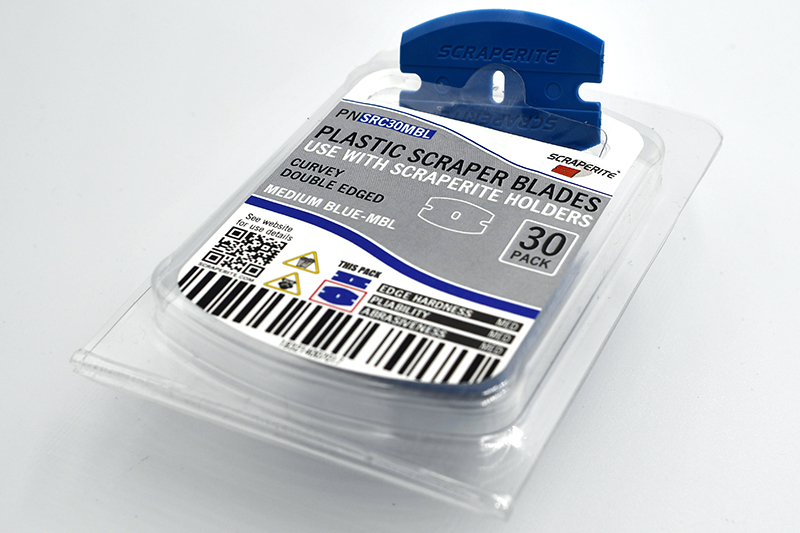
How to Use Plastic Scrapers in the Kitchen
Scraperite plastic scrapers are versatile tools with a wide range of applications, from automotive detailing to industrial settings. But did you know they can also be incredibly handy in the kitchen? Whether you're prepping food, cleaning delicate surfaces, or removing stubborn labels from new kitchenware, a plastic scraper can make these tasks easier and more efficient. Below we will explore some of the best ways to use Scraperite plastic scrapers in the kitchen. With the right scraper on hand, you can save time and elbow grease, and avoid damaging your cookware. 1. Removing Stickers from New Kitchenware Have you ever purchased a new set of glass jars, baking dishes, or a beautiful coffee maker, only to find it covered in stubborn price tags or sticky labels? Fully removing these adhesives without leaving residue or damaging the surface can be a challenge, but with a plastic scraper, it becomes a breeze. Plastic scrapers, like Scraperite's General Purpose Orange, are perfect for this task as they provide a safe and effective way to remove adhesives and stickers around your home. Whether it be a glass container, stainless steel pot, or ceramic dish, a scraper helps lift the adhesive without damaging the finish underneath. However, make sure to use the correct method to remove these stickers. Click here to read about different ways to remove adhesive from glass, ceramic, plastic, and stainless steel. 2. Scraping Dough from Counters and Surfaces Baking often involves working with sticky doughs that can easily cling to your countertops, mixing bowls, or rolling pins when dry. A plastic scraper can help make clean-up easier by quickly lifting dough and other sticky substances off surfaces without creating a mess. The flat edge of a scraper is perfect for gathering up dough scraps or cleaning up flour residue from your workspace. In addition, plastic scrapers are gentle enough not to damage delicate countertops like granite, marble, or wood, making them a safe tool for kitchen use. Be sure to wet the area with a cleaning spray of your choice or warm water to make the removal a breeze. Gently scrape with a plastic scraper, like Scraperite's Dwarf Orange Blade, to remove stuck on food. 3. Cleaning Grills and Cookware Non-stick pans, cast iron cookware, and grills require special care to avoid damaging the surface while removing stuck on food. A plastic scraper can be used to gently remove burnt food, grease, or residue without scratching or compromising the surface, whether it be a cast iron pan, stainless steel, non-stick pan, or the grates on your grill. Using a plastic scraper will help maintain the integrity of your cookware while getting the job done. Make sure you wet the surface with warm water to loosen the stuck-on food and gently scrape with your plastic blade until it's removed. For cleaning grills or pots and pans, a scraper with a sturdy plastic blade, such as the Scraperite Pro Magenta Blade, is an ideal choice. It's durable enough to tackle built-up grease and grime but gentle on the surfaces you're cleaning. 4. Removing Food Residue from Cutting Boards Cutting boards can accumulate stubborn food residue, especially after slicing sticky ingredients like tomatoes, cheese, or fruit. Plastic scrapers are perfect for quickly lifting off food particles and sticky substances without the risk of scratching the surface of your board. This is especially useful for wooden or bamboo cutting boards, which can be prone to damage from abrasive scrubbers. By using a plastic scraper, you can ensure that your cutting board remains in good condition and free of leftover food debris, making cleaning a faster and more efficient task. 5. Dealing with Sticky Messes in the Kitchen Accidents happen in the kitchen, and sometimes sticky spills or drips from syrups, honey, or sauces can leave a mess. Whether it's spilled jam on the countertop or melted sugar on your stovetop, a plastic scraper is a great tool for getting into corners and removing the sticky residue. Unlike metal scrapers, which can scratch surfaces, plastic scrapers like Scraperite's General Purpose Orange, are safe and flexible enough to use on delicate kitchen surfaces. The flexibility of a plastic scraper also makes it easy to get into tight spots or angles, ensuring that you can clean up every last bit of residue. 8. Cleaning the Refrigerator: Scraping Away Stubborn Spills and Residue The refrigerator is one of the busiest—and often messiest—appliances in the kitchen. Spills from sauces, drinks, or food items can create sticky spots that are hard to clean, especially in tight corners or under shelves. A plastic scraper is perfect for tackling these areas. Whether you're scraping away dried spills on shelves or removing stubborn gooey messes from drawers, a plastic scraper can help you lift residue without scratching or damaging the fridge's surfaces. It's also ideal for cleaning food crumbs or sticky residues from the door seals, which can trap dirt and mold over time. With a scraper, you can keep your fridge looking fresh and ensure that food stays safe and hygienic, all while avoiding harsh scrubbing that could damage delicate parts. Use a long handled scraper for reaching under shelves, and a dwarf scraper for detailed work in the corners. Conclusion: A Kitchen Essential Plastic scrapers are versatile tools that belong in every kitchen. Whether you're peeling, spreading, scraping, or cleaning, they provide an easy and effective solution for many common kitchen tasks. By choosing the right plastic scraper for the job—like Scraperite's General Purpose Orange Blade for removing sticky labels, or the Pro Magenta Blade for cleaning grime off surfaces—kitchen chores become simpler and more efficient. The best part? Plastic scrapers are safe to use on a variety of surfaces, preventing scratches and damage while ensuring that your kitchenware and countertops remain in pristine condition. If you're looking for an affordable and practical tool to add to your kitchen toolkit, look no further than a plastic scraper.
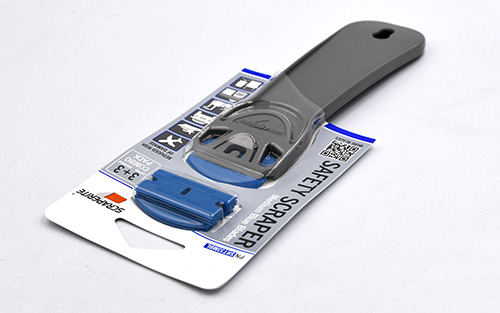
How To: Removing Price Tags from Your Holiday Gifts
The holiday season is full of gift-giving, but one task many of us dread is removing those stubborn price tags and labels from our carefully chosen presents. Whether you've purchased a new bottle of wine, a decorative item, or a children's toy, removing price tags completely and without damaging the product can be tricky. Don't worry, though—we've got you covered with effective methods to tackle this common problem. Here are four hassle-free ways to use Scraperite's plastic blades to remove price tags. Method 1: Nail Polish Remover and Rubbing Alcohol If you're dealing with a sticker that refuses to come off, this method is a reliable solution. Nail polish remover contains acetone, which breaks down adhesives. Steps: Soak a cotton ball, cloth, or paper towel with nail polish remover. Place it over the label, letting it sit for a few minutes to allow the remover to penetrate. Carefully peel off the label. Use a plastic scraper, like Scraperite's General Purpose Orange, to remove any leftover sticky residue. Wipe the area clean with a damp cloth. Tip: This method works well for glass, metal, and plastic surfaces, but always test it on an inconspicuous spot first to ensure no discoloration. Method 2: Warm Water Soak A simple and effective method for labels on jars, bottles, and plastic items. Soaking the object in warm water softens the adhesive, making it easier to peel off. Steps: Fill a sink or container with warm water and add a scoop of dish detergent or OxiClean®. Submerge your item and let it soak—overnight if the adhesive is particularly stubborn. Peel away the label from a corner. Use a plastic blade to gently and effectively remove any sticky residue. Wipe the surface clean with a cloth or sponge. Tip: If you're dealing with bottles, try filling them with warm water for an easy soak. Method 3: Hair Dryer For tougher labels that don't want to peel, heat can be a game-changer. A hair dryer works by loosening the adhesive, making it easier to remove. Steps: Set the hair dryer on warm heat and direct it at the label for about a minute. Slowly move the dryer across the label until it starts to peel off. You can use an efficient plastic blade like Scraperite's Magenta Pro to clean off any leftover adhesive. Wipe the surface clean with a damp cloth. Tip: This method is especially effective on glass and plastic surfaces, but make sure the heat doesn't get too intense for delicate items. Method 4: Vinegar Vinegar is a fantastic natural adhesive remover. Its acidity breaks down the adhesive without damaging most surfaces. Steps: Heat white vinegar in the microwave or on the stovetop (don't let it boil). Soak the item in the warm vinegar or place a cloth soaked in vinegar over the label for 15-30 minutes. Peel off the label easily, then use one of Scraperite's plastic blades to get rid of any remaining adhesive. Wipe the surface clean with a cloth or sponge. Tip: This works great on ceramic, porcelain, and glass items, and it's particularly useful for removing sticky residue. Method 5: Label Removal Sprays (Goo Gone) If you have particularly stubborn stickers or sticky residue, commercial label removal sprays like Goo Gone can be a lifesaver. Steps: Spray a generous amount of Goo Gone or a similar product onto the label. Cover with a cloth and let it sit for 15-30 minutes. Peel off the label and use a plastic scraper like our General Purpose Dwarf Orange. to clean off any residue. Wipe the surface clean with a damp cloth. Tip: This method works well for all surfaces, including plastic and metal. Surface-Specific Tips for Label Removal Glass: Water works wonders on glass labels, especially on bottles or jars. For tough labels, use a hair dryer or nail polish remover. Metal & Tin: Soak the label with a damp rag and allow it to sit until the adhesive loosens. A plastic scraper will help remove any residue. Plastic: Plastic items tend to hold onto labels tightly. Nail polish remover, rubbing alcohol, or a hair dryer are best for these surfaces. Ceramic & Porcelain: Vinegar is your best friend for removing paper labels from these delicate materials without leaving residue behind. Conclusion With these tried-and-true methods, you'll be able to remove price tags and labels from your holiday gifts quickly and easily, leaving your presents looking clean and polished. Just remember to test any removal solution on a small, hidden area first to make sure it's safe for your item's surface. For best results, always use a reliable plastic scraper like Scraperite to ensure a smooth, residue-free finish. Happy gifting, and here's to a tag-free holiday season!
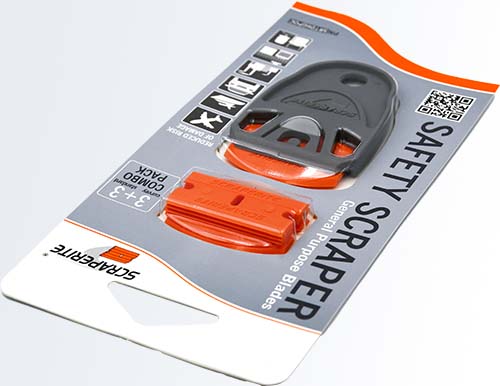
How to remove stickers (or adhesive) from your car's windshield using Scraperite and Goo Gone.
How to remove stickers (or adhesive) from your car's windshield using Scraperite and Goo Gone @Googone We are using the general purpose orange blade and a bit of goo gone. Sticker adhesive can be a real pain to get off cleanly. This method is just using a plastic scraper that won't scratch (Scraperite of Course) to scrape and pull the majority of the sticker then a bit of Goo Gone to loosen it up then just go to town with the Scraperite. You don't have to worry that the Scraperite will scratch the glass so you can be as aggressive as you need. Wipe clean with a paper towel and hose off the vehicle. Goo Gone is safe on glass and most other materials but rinse it off regardless. This same method works for removing decals as well. #cardetailing #cleaninghacks #automobile #worktips #stickers